 |
|
The Pride of Chanur; Redwall: the Graphic Novel and Pride of Baghdad |
|
      
|
 |
A quick note first: This novel is completely standalone. The next three paste this universe into Cherryh’s Downbelow Station universe; do not start reading them until you have all three (they’re really one big novel in three volumes). The last is also standalone. There was an omnibus printing of the first three novels (up to The Kif Strike Back!), so do not start reading the 2nd and 3rd novels in that until you have a copy of Chanur’s Homecoming.
Those who have read my writing articles have seen me reference this novel a number of times. It has had a major influence on my writing, both in furry race creation, and in science fiction. It is certainly worth reading for that reason for furry writers. And yet…
In essence, the novel is the story of one Pyanfar Chanur, captain of the Hani trading vessel The Pride of Chanur. She, and her ship, are just minding their business at Meetpoint Station when an unknown alien—some sort of weird, hairless ape-thing—sneaks aboard her ship. Nobody can communicate with it, and the Kif want it at any cost.
And then the crap hits the fan as everybody wants a piece of the action, and of the alien.
The Hani are anthropomorphic lions. The Kif are anthropomorphic rats. Different names, some visual differences, but that’s what they are. Nevertheless, they are well done. It took me years to realize that she had made those races seem real simply by applying the sociological aspects of the appropriate human culture to the species. And, even better, making those aspects dominant in a way that is strangely and wondrously different from typical human psychology. In fact, the novel is told from the point-of-view of Pyanfar, and there is only one human in the novel. The hairless ape-thing. He says little (understandably so, given the lack of language translation), has little power, and still manages to drive the novel.
Perhaps it sounds like an incoherent melange, but, well, it works.
And yet…
When I first read it in the mid-’80s, it blew me away. Cherryh’s style has permeated my own, and my descriptions are influenced by hers. But when I reread it for this review, it almost fell flat. Oh, not the personalities of the aliens, of the characters. Not the fast paced writing, nor the wondrous and simply done SF bits. (Yes, this is hard SF in the truest sense, but I bet not a single mathematical calculation was ever done).
For me, at least, the problem is that the ending is a rather severe anticlimax. The narrative consists almost entirely of panic, panic, panic—and then, almost instantly, everything gets fixed in the final chapter. Oh, Pyanfar works her tail off to earn her happy ending, it all makes sense, no deus ex machina or anything like that. And yet, and yet, and yet… somehow, it just wasn’t as satisfying as I remember.
The next three books are, in my opinion, far better. The last one (Chanur’s Legacy) focuses on a different main character; it is okay, but not as good as the trilogy. Even so, you really do need to read this one first.
So: Pride of Chanur is fast-paced and easy to read. Well and cleanly written. Exciting and full of ideas and stylistic concepts for furry writers (though still worthwhile for non-writers). And it is certainly worthwhile to read. So go, enjoy, think.
If only it could have been better…
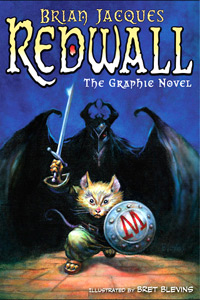 |
|
|
| Title: |
Redwall: the Graphic Novel |
| Writer: |
Stuart Moore (adapted from the book by Brian Jacques) |
| Artist: |
Bret Blevins |
| Publisher: |
Philomel Books (Penguin), 2007 |
| ISBN: |
9780399244810 |
|
B/W softcover, 143 pages, USD $12.99 |
|
|
reviewed by Dronon
©2008 Dronon
Anyone familiar with Brian Jacques’ Redwall novels knows they’re for kids, so if you’re an adult reader looking for deep meaning and complex characters, this isn’t for you. But the graphic novel does make a great fantasy adventure for the younger set.
If you’re not familiar with the story of Redwall, its eighteen sequels or the animated series, the basic setting involves a religious order of mice and other animals in Redwall Abbey who are suddenly forced into defending themselves against a sadistic rat known as Cluny the Scourge and his rag-tag army of followers. The protagonist is a young mouse named Matthias who discovers he is the reincarnation of a celebrated warrior, and sets out to recover a long-lost sword and defeat Cluny.
The artwork is delivered in shades of black, white and charcoal grays, which really adds to the medieval atmosphere. On the negative side, the absence of color makes most of the minor side-characters look the same, and if Matthias lost his sword belt, he would look very unremarkable. The bad guys, on the other hand, are easy to identify: all evil characters are ugly. This isn’t unusual for a kid’s book, but at times it made it difficult to identify species. On the positive side, the artistic style is perfect for Cluny, who is both scary and intimidating.
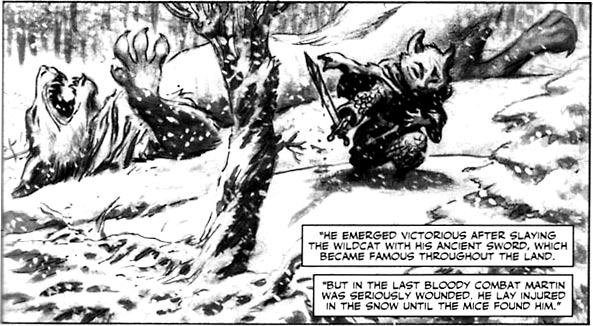
Story-wise, it’s a challenging book to turn into a graphic novel. The original paperback runs for over 300 pages with frequent scene changes and plot twists. As a result, some parts of the book pass rather quickly in the graphic novel. Asmodeus’ body count is reduced, Cornflower’s role is underplayed, and the ‘One year later’ epilogue is gone, making for a somewhat abrupt and darker ‘We won, but at what cost?’ ending.
Nevertheless, Moore’s adaptation is extremely faithful to the original, and coupled with Blevins’ sense of layout, the whole story is basically here, memorable dialog and all. This is a great buy for kids who are into comics, and if you’re unsure about the content, reading the book first will tell you everything you need to know.
Stuart Moore has written for numerous comics and graphic novels. Bret Blevins is a comic book artist whose past work has included The New Mutants and an adaptation of The Dark Crystal.
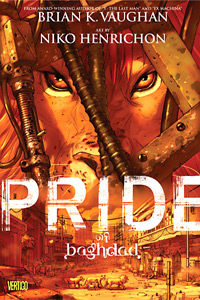 |
|
|
| Title: |
Pride of Baghdad |
| Writer: |
Brian K. Vaughan |
| Artist: |
Niko Henrichon |
| Publisher: |
Vertigo Comics (DC), 2006 |
| ISBN: |
1401203140 (HC), 1401203159 (SC) |
|
Color, 136 pages, USD $19.99 |
|
|
reviewed by Dronon
©2008 Dronon
During the 2003 invasion of Iraq, the animals in the Baghdad zoo suffered heavy losses due to warfare and looting. Four of the zoo’s lions managed to escape, and were shot when they charged a group of U.S. soldiers. This incident served as the inspiration for the graphic novel Pride of Baghdad, written by Brian K. Vaughan and drawn by Niko Henrichon.
The story centers around four lions in the zoo during the outbreak of the invasion. When a bomb blasts open their enclosure’s wall, they make their way into the outside world and must first get away from the other panicked zoo animals, only to meet other challenges as they go on, starvation being a major concern. After avoiding a tank patrol, they follow the trail into an abandoned urban area and enter a palace, where they meet and overcome a dangerous bear. As night begins to fall, they return to the streets of the rubble-strewn city before being tragically shot.
That might not sound like much of a plot, but that’s because this is largely a character-driven story; the lions have very distinct personalities and attitudes towards their situation. Zill is an adult male, at some times forceful and at other times showing a lot of self-doubt. Noor is a bold lioness who had been scheming an escape plan long before the attack, and strongly believes in keeping her word. Ali is their cub, young and excited at being able to explore the world. And finally there’s Safa, an old, bitter and extremely jaded lioness.
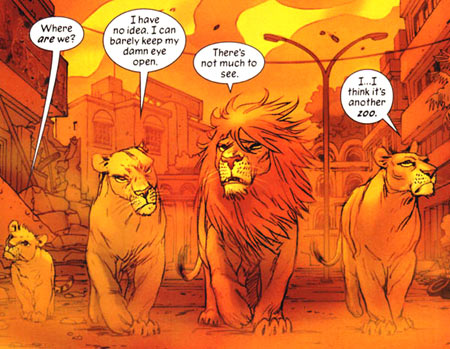 The dialog and interactions of these four characters are a real strength in this graphic novel. While the lions are willing to work as a team, they’re also fiercely independent, even dysfunctional, and this has been written in a way that feels very feline. The artwork is also excellent. One thing that especially impressed me were pages where the dominant shades were all yellow and oranges—the coloring was subtle and effective in creating distinctions while avoiding a flat look. For the squeamish, be warned that it doesn’t shy away from showing animal violence and death—but be comforted that neither is it a gratuitous gore-fest.
The dialog and interactions of these four characters are a real strength in this graphic novel. While the lions are willing to work as a team, they’re also fiercely independent, even dysfunctional, and this has been written in a way that feels very feline. The artwork is also excellent. One thing that especially impressed me were pages where the dominant shades were all yellow and oranges—the coloring was subtle and effective in creating distinctions while avoiding a flat look. For the squeamish, be warned that it doesn’t shy away from showing animal violence and death—but be comforted that neither is it a gratuitous gore-fest.
Given the wartime setting, you might expect this book to be beating you over the head about the morality of the Iraq War, but this is not the case. Aside from one rather obvious statement about pollution, the story treats the reader with respect, wanting you to think and draw your own conclusions. Above all, the recurring theme is that of being trapped—be it by walls, society, memories, ethics, beliefs, or basic needs—and there are no clear answers to its ultimate question: What does it mean to be free?
Brian K. Vaughan is an American writer and Eisner award winner, currently living in California. He has written for numerous comic book series and is beginning to branch out into other media. Niko Henrichon is a Canadian comic book artist who lives in Quebec. Pride of Baghdad is his second graphic novel. Since 2003, the Baghdad zoo has managed to slowly recover itself with the help of the U.S. Army and foreign aid. As of early 2008, the zoo has 22 lions.
Seen any furriness recently that you think other people should know about?
Whether it’s a novel, comicbook, movie, or whatever else, write a review and send it to Anthro!


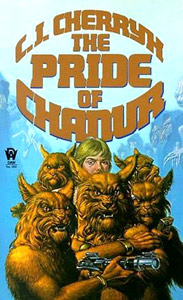



 The dialog and interactions of these four characters are a real strength in this graphic novel. While the lions are willing to work as a team, they’re also fiercely independent, even dysfunctional, and this has been written in a way that feels very feline. The artwork is also excellent. One thing that especially impressed me were pages where the dominant shades were all yellow and oranges—the coloring was subtle and effective in creating distinctions while avoiding a flat look. For the squeamish, be warned that it doesn’t shy away from showing animal violence and death—but be comforted that neither is it a gratuitous gore-fest.
The dialog and interactions of these four characters are a real strength in this graphic novel. While the lions are willing to work as a team, they’re also fiercely independent, even dysfunctional, and this has been written in a way that feels very feline. The artwork is also excellent. One thing that especially impressed me were pages where the dominant shades were all yellow and oranges—the coloring was subtle and effective in creating distinctions while avoiding a flat look. For the squeamish, be warned that it doesn’t shy away from showing animal violence and death—but be comforted that neither is it a gratuitous gore-fest.